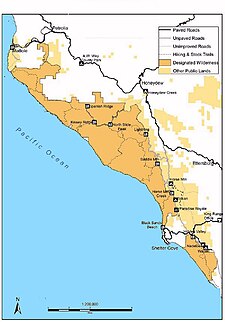| King Range Wilderness | |
|---|---|
 | |
| Location | Humboldt County / Mendocino County |
| Nearest city | Ferndale, California |
| Coordinates | 40°09′55″N 124°08′03″W / 40.16528°N 124.13417°W |
| Area | 42,585 acres (172 km2) |
| Established | 2006 |
| Governing body | Bureau of Land Management |
The King Range Wilderness is a 42,585-acre (172 km2) federally designated wilderness area within the King Range National Conservation Area in northern California, United States. The area was set aside with the passage of the Northern California Coastal Wild Heritage Wilderness Act of 2006 (Public Law 109–362). The Bureau of Land Management is the responsible agency and is currently working on a Management Plan for the King Range Wilderness.[1] This section of California's coastline is known as the "Lost Coast", a landscape too rugged for highway building, which forced the construction of State Highway 1 and U.S. 101 inland.[2] The King Range Wilderness is the longest undeveloped coast, outside of Alaska, in the United States.[3]
The Act of 2006 also set aside an area three geographical miles offshore as the Rocks and Islands Wilderness. It is the smallest wilderness area in the National Wilderness Preservation System, with a total size of five acres (2.0 ha).[4]
The King Range is part of the Coast Ranges mountains and has the greatest relief in the shortest distance of all coast ranges in the state. In the lateral distance of three miles (5 km), the King Range rises from sea level to over 4,000 feet (1,200 m).[5]
There are four areas of botanical significance: Old growth forest of Douglas-fir on the east slopes of King Range, dune system of the Mattole River, undisturbed coastal prairie, and coastal stands of reedgrass. Wildlife include black-tailed deer, black bear, mountain lion, and the re-introduced Roosevelt elk. Bird species include quail, grouse, dove, hawks, turkey vultures and osprey.
Marine animals include harbor seals, Steller and California sea lions, and river otter.
The Honeydew Creek Wildlife Preserve protects 2,980 acres (12 km2) of habitat north of King Peak for bald eagle, northern spotted owl, mink and anadromous fish.[6]
- ^ BLM King Range NCA-Wilderness Archived 2009-01-11 at the Wayback Machine accessed Feb. 4, 2009
- ^ BLM website, King Range NCA index page.
- ^ "King Range Wilderness". Wilderness.net. Retrieved February 28, 2009.
- ^ "Wilderness Fast Facts". Wilderness.net. Archived from the original on June 14, 2019. Retrieved February 28, 2009.
- ^ Adkinson 2001, p. 244.
- ^ Adkinson 2001, p. 247.
© MMXXIII Rich X Search. We shall prevail. All rights reserved. Rich X Search
